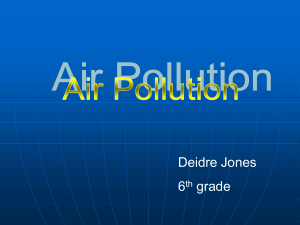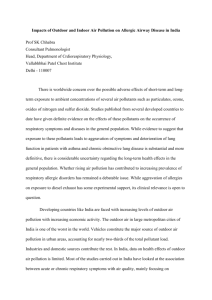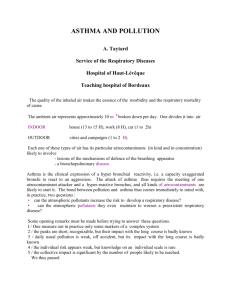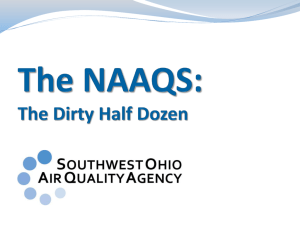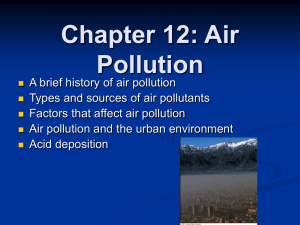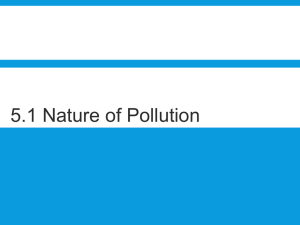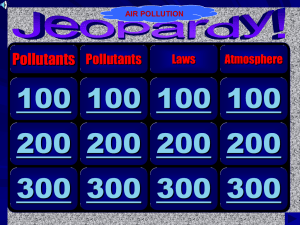Air Pollution power point
advertisement
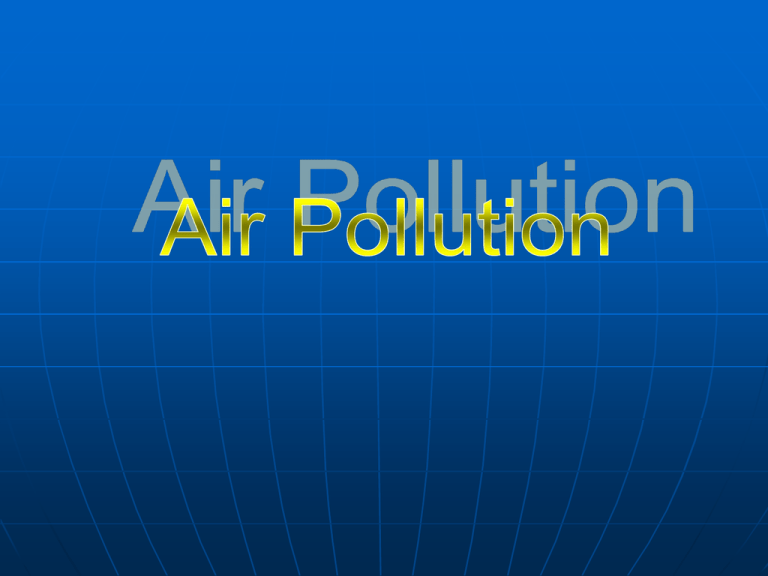
•Any visible or invisible particle or gas that has ended up in the air that is not part of the original, normal composition. Air pollution (Particles and gases) endanger the health and well being of organsims . Natural: forest fires (smoke), pollen, dust storm, sea salt, volcanic gases and ash, Unnatural: man-made; coal, wood and other fuels used in cars, homes, and factories for energy (carbon monoxide, smoke , chemicals, NOX, SOX, VOCS Primary Pollutants Pollutants that are put directly into the air by human or natural activity Dust, sea salt, volcanic gases, ash, smoke, carbon monoxide, paint fumes, car exhaust, particulate matter, sulfur dioxide, nitrogen oxides, volatile organic compounds Secondary Pollutants Pollutants that form when primary pollutants react with other primary pollutants or with naturally occuring substances Ozone, smog, sulfuric acid (precipiation), AQI: Air Quality Index •Indicates whether pollutant levels in air may cause health concerns. •Ranges from 0 (least concern) to 500 (greatest concern) Air Quality Air Quality Index Good 0-50 No health impacts are expected when air quality is in this range. Moderate 51-100 Unusually sensitive people should consider limiting prolonged outdoor exertion. Unhealthy for Sensitive Groups 101-150 Active children and adults, and people with respiratory disease, such as asthma, should limit prolonged outdoor exertion. Unhealthy Protect Your Health 151-200 Active children and adults, and people with respiratory disease, such as asthma, should limit prolonged outdoor exertion, everyone else, especially children should limit prolonged outdoor excertion. Very Unhealthy (Alert) 201-300 Active children and adults, and people with respiratory disease, such as asthma, should limit prolonged outdoor exertion everyone else, especially children, should limit outdoor exertion. Carbon Monoxide •colorless, odorless •produced when carbon does not burn in fossil fuels •present in car exhaust, faulty furnaces in homes •deprives body of O2 causing headaches, fatigue, and impaired vision Sulfur Dioxide •produced when coal and fuel oil are burned •present in power plant exhaust •narrows the airway, causing wheezing and shortness of breath, especially in those with asthma Nitrogen Dioxide •reddish, brown gas •produced when nitric oxide combines with oxygen in the atmosphere •present in car exhaust and power plants •affects lungs and causes wheezing; increases chance of respiratory infection Particulate Matter •particles of different sizes and structures that are released into the atmosphere •present in many sources including fossil fuels, dust, smoke, fog, etc. •can build up in respiratory system •aggravates heart and lung disease; increases risk of respiratory infection Ground Level Ozone •at upper level, ozone shields Earth from sun’s harmful UV rays •at ground level, ozone is harmful pollutants •formed from car, power and chemical plant exhaust •irritate respiratory system and asthma; reduces lung function by inflaming and damaging lining of lungs •Combination of gases with water vapor and dust •Combination of words smoke and fog •Forms when heat and sunlight react gases (photochemical smog) •Occurs often with heavy traffic, high temperatures, and calm winds •1st smog related deaths were in London in 1873; death toll 500 people; can you imagine how much worse the atmosphere is now?! •Limits visibility •Decreases UV radiation •Yellow/black color over cities •Causes respiratory problems and bronchial related deaths Yes! Air pollution can occur indoors Americans spend about 85% of their time indoors Plastics, carpets, furniture, paints, building materials, asbestos, fungi, bacteria, radon, smoke, benzene and other compounds can be sources of pollution Sick building syndrome is where a building has very poor air quality Laws and regulations EPA (Environmental Protection Agency) regulates laws and emissions Clean Air Act Clean Air Act Passed in 1970 and strengthened in 1990 Regulates automobile emissions Eliminated lead in gasoline Mandated catalytic converters and cleaner exhaust systems for cars Requires industry to use scrubbers or other pollution control devices (especially in power plants and factories) •Ride your bike •Tell your friends and family about pollution •Make sure your parents get pollution checks on their cars •Ride the school bus •Learn more; stay up to date •Join a group to stop pollution •Encourage your parents to carpool to work •Switch off lights, fan, heat, etc. when you leave the room •Insel, Paul M. and Roth, Walton T. Core Concepts in Health: 9th edition. McGraw Hill: Boston, 2002. •http://edugreen.teri.in/explore/air.htm •http://www.oneworld.net/penguin/pollution/pollution_home .html •http://www.rcc.org/oem/aqindex.html •http://www.tnrcc.state.tx.us/air/monops/lessoms/mathlesson.h tml
